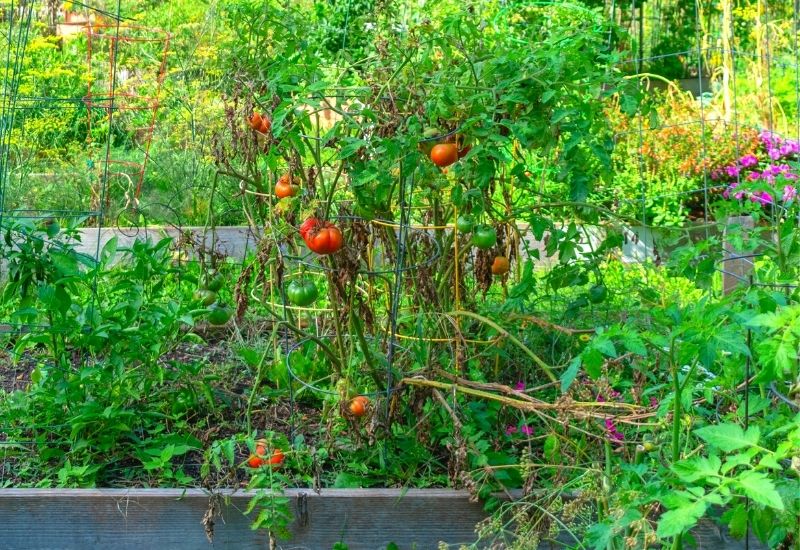
Companion planting is a traditional gardening technique that has been used by indigenous peoples across the world for centuries.
Companion planting can offer a diverse array of benefits that can help your tomato plants become stronger and healthier than ever before, and they will leave your garden more diverse and resilient for future seasons.
Companion planting tomatoes with plant partners like asparagus, basil, beans, borage, carrot, celery, chives, cucumber, garlic, lettuce can provide many different services, like attracting pollinators, deterring pests, improving fruit flavor, or mulching the soil surface.
The best part is that many of them are common garden crops or herbs, and all you need to do is strategically place them close to your tomatoes!
While there a many popular garden vegetables and herbs suitable for growing alongside tomatoes, but there are also vegetables and plants that you should avoid planting near tomatoes. This may be because they compete for space, light, water, soil nutrients, or attract insects detrimental.
In the following article, we will discuss the benefits of companion planting with tomatoes and plants that make excellent companions for tomatoes along with plants that should be kept apart from tomato plants in the garden.
Companion Planting in a Nutshell
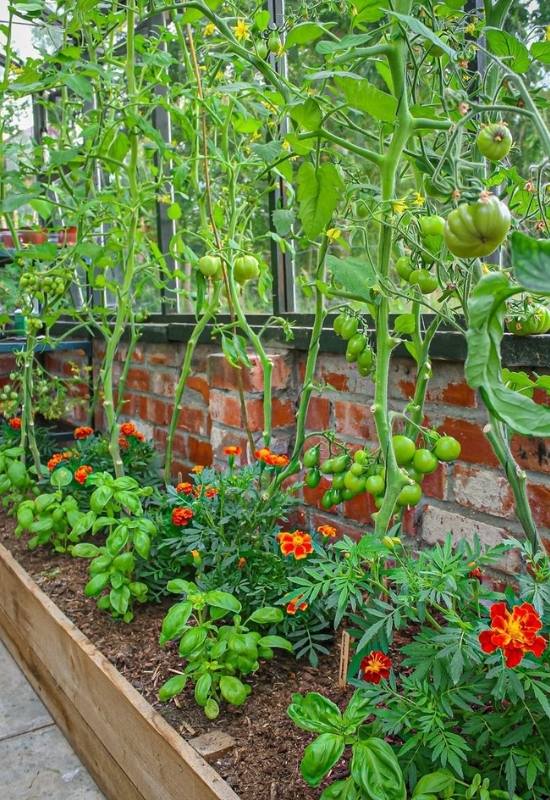
If you are new to the concept, companion planting is the practice of growing different plants together for the co-benefits they can offer each other.
Gardens that companion plant become intercropped polycultures, as opposed to monocultures, and develop a rich biodiversity that creates a garden ecosystem.
Companion planting applies to growing trees, crops, ornamental flowers, and herbs, all of which can offer unique benefits to other specific plants.
Since tomatoes have their own specific set of needs, there is a unique group of companion plants best suited for growing together with tomatoes.
There are also plants that are antagonistic and will inhibit the growth of certain plants, so read on to learn which plants you definitely don’t want near your tomatoes!
The Benefits Companion Planting for Tomatoes
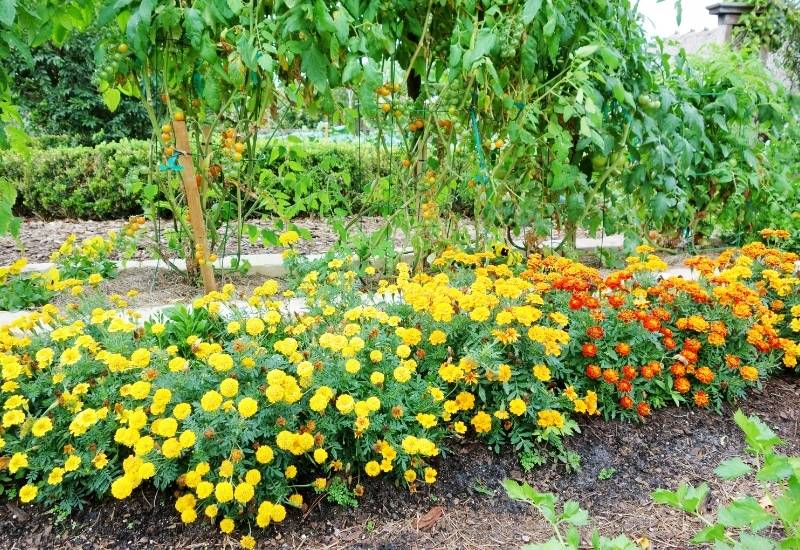
Before you start mapping out your garden and your tomato planting according to companion planting, you might want to better understand the distinct benefits it can offer your plants.
Although certain companion plants might just fall into one of the following categories, many will fulfill multiple and create the optimal conditions for your tomato to grow and thrive.
Here are the main reasons to plant your tomatoes with some friends:
Attracts pollinators and other beneficial insects
Tomatoes need to have their flowers pollinated in order to develop fruit! Pollinators like bees and butterflies can be brought to your tomato plants if you have strategically placed something like bee balm next to them, and drastically increase the rates of pollination that occur, therefore boosting fruit production.
There are also certain plants that will attract other beneficials like predatory insects that prey on some of the pests that attack tomatoes.
Deters pests and disease pathogens
Aside from attracting beneficial insects, companion plants can also actively deter pests that are after your tomatoes with their powerful scent.
Garlic is a great companion plant that keeps away tomato hornworm and also releases a sulphuric compound into the soil that deters soil-borne fungal diseases from spreading.
Many insect pests will create wounds in the stem, leaves, or fruit of your tomato that then creates entrances for disease pathogens to enter the plant, and companion planting offers a ‘kill two birds with one stone’ solution by mitigating both issues.
Replenish Nutrients In The Soil
Tomatoes are heavy feeders that like lots of nitrogen, phosphorus, and potassium to fuel their growth, and sometimes this doesn’t leave much for the other plants growing nearby.
The companion plants of tomatoes often have different nutrient needs so that they are not competing with each other and can happily co-exist, but there are also certain plants that will actively replenish nutrients in the soil to maintain a balance.
Beans are a common companion plant for tomatoes since they are nitrogen-fixing and will increase the availability of nitrogen in the soil.
Provides a living mulch and shades the soil
Low-growing, shallow-rooted plants with different nutrient needs can be planted around the base of tomato plants to control weed growth and shade the soil, acting as a sort of living mulch.
This is also highly beneficial for the soil, as leaving bare ground exposed can increase wind erosion and dry out the ground quickly in the heat of summer.
Low-growing crops will retain moisture so that the water you use to irrigate is used more efficiently, and the roots of your tomato plant are protected. Some varieties of clover are ideal for this purpose and as an added bonus will also fix nitrogen!
Increases the productivity of a space
Companion planting with tomatoes offers physical benefits that take advantage of the shape and size of the plant so that more crops can be grown together.
As mentioned above, lower growing and mid-sized plants can be staggered with tomatoes so that you have a tiered growing system that really takes advantage of your space.
It’s all about pairing the right plants together, like annuals and perennials, as you don’t want them to compete with each other but offer co-benefits and successional harvests.This benefit is also considered a practice of its own called interplanting.
Alternatively, planting tomatoes with crops that have the same growing season can also prove helpful so that you can clear the bed all at once for an easy fall planting.
24 Companion Plants to Grow with Tomatoes
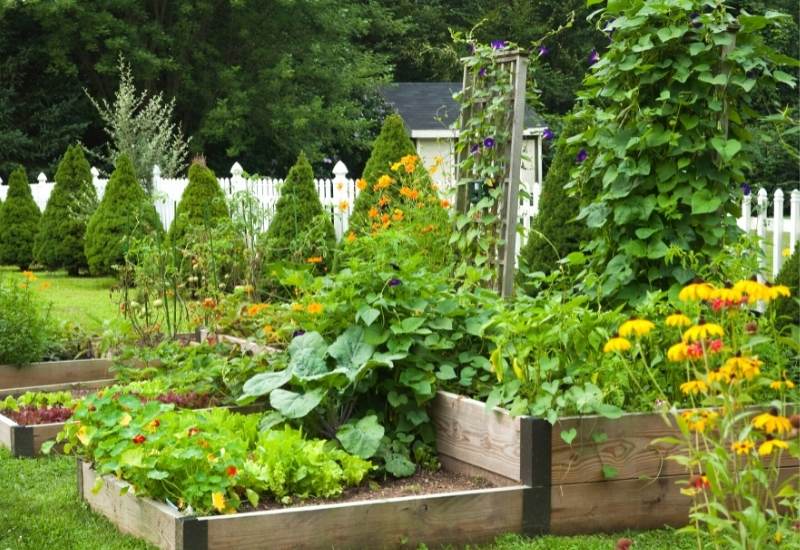
Now that you are convinced of the fantastic benefits companion planting offers, you probably want to know what to plant!
Here are the 24 best companion plants to grow with tomatoes, and how they will help your plants and garden flourish.
1: Asparagus
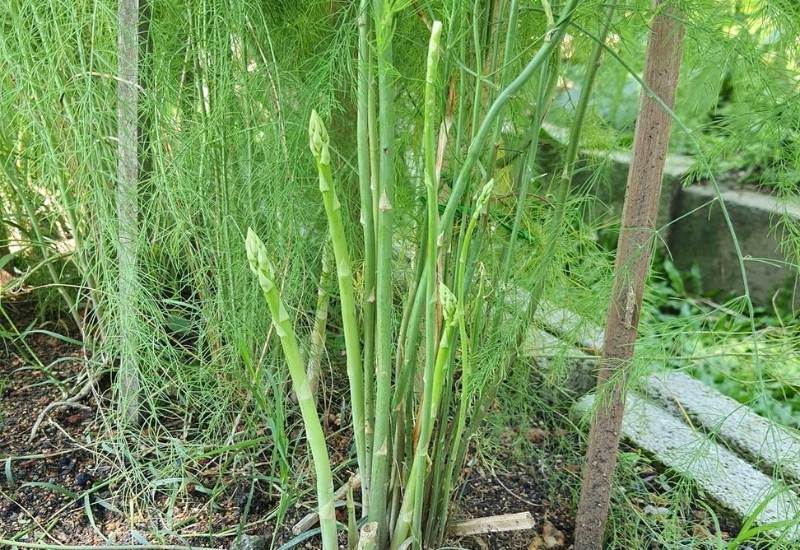
Asparagus is a perennial vegetable that will become established wherever you plant it. Intercropping tomatoes with asparagus makes efficient use of your space as the two crops are harvested at different times of the year – asparagus in the spring and tomatoes in mid to late summer.
Tomatoes benefit asparagus by deterring the asparagus beetle through a chemical they excrete (solanine), and asparagus keeps away the parasitic nematodes that can go after tomato roots.
How and when to plant with tomatoes:
After you have harvested the asparagus stalks in the spring, plant tomatoes on either end of the bed. Asparagus has a somewhat fragile root system so don’t plant directly where you have harvested from.
2: Basil

Basil is one of the most famous companions for tomatoes, and growing them in the same bed means a one-stop-shop for cooking italian cuisine.
Basil has a strong scent that repels flies and the notorious tomato hornworm, and it is also said to improve the flavor and richness of the fruits. Basil is considerably shorter than mature tomato plants, so they make use of the space efficiently.
How and when to plant with tomatoes:
Plant basil starts at the same time that you plant your tomato seedlings in the late spring/early summer. Basil is also heat-loving so it requires the same outside conditions as tomatoes for transplanting.
Plant near the base of indeterminate tomatoes that will be pruned throughout the season so that they don’t shade the basil. If growing determinate tomatoes that are very bushy, plant basil starts at the end of the rows or beds.
3: Beans
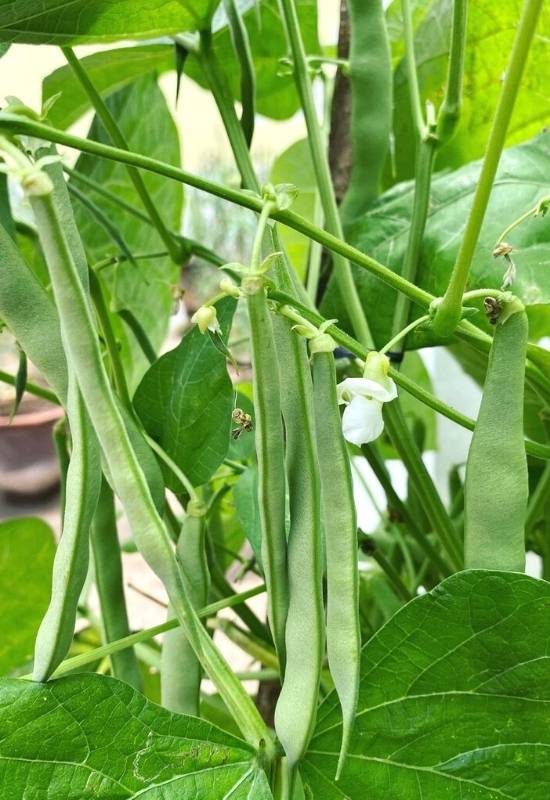
Beans are an excellent companion plant for many crops, including tomatoes, since they fix nitrogen in the soil. Tomatoes are heavy nitrogen feeders so growing them with beans means that the soil can be constantly replenished and won’t be depleted by the end of the season.
Both tomatoes and beans are annuals that will grow and produce over a similar time frame throughout the summer, and at the end of the season the bed can be cleared all at once to plant a fall crop.
How and when to plant with tomatoes:
Pole and bush beans can be planted with tomatoes, and the seeds should be sown at the same time that tomato seedlings are transplanted to stagger the initial growing period.
Climbing pole beans can be planted on the northside of tomatoes but bush beans should be planted on the south side to prevent the tomatoes from shading them.
Make sure to space pole beans far enough away from tomatoes that they won’t become entangled.
4: Borage

Borage is another popular companion herb for many crops including tomatoes since it is beloved by bees and pollinators everywhere.
It’s purple flowers are attractive to bees and bloom throughout the season which is great for indeterminate tomato plants that need constant pollination to support their continuous fruit production. Borage’s aroma also deters the tomato hornworm.
How and when to plant with tomatoes:
Borage is a self-seeding annual that will likely pop up in the same spot for several years. Plant borage seeds in the spring before transplanting tomatoes to give them some time to establish.
Borage should be planted at the end of tomato beds where its bushy growth can expand and return every year without getting in the way.
5: Carrots

Carrots and tomatoes are mutually beneficial to one another for multiple reasons. Since carrots are a root vegetable, their penetration through the soil aerates and loosens the ground around tomato roots allowing them to receive more oxygen and moisture.
Carrots are typically grown as cool season crops but their season can be extended when grown with tomatoes which provide them with ample shade. The solanine produced by tomatoes also deters common carrot pests.
How and when to plant with tomatoes:
Direct seed carrots around the base of recently transplanted tomatoes, so that there is already sufficient shade after sprouting. Make sure not to plant them too densely or too close to the base, as this will inhibit the size of the carrots.
6: Celery
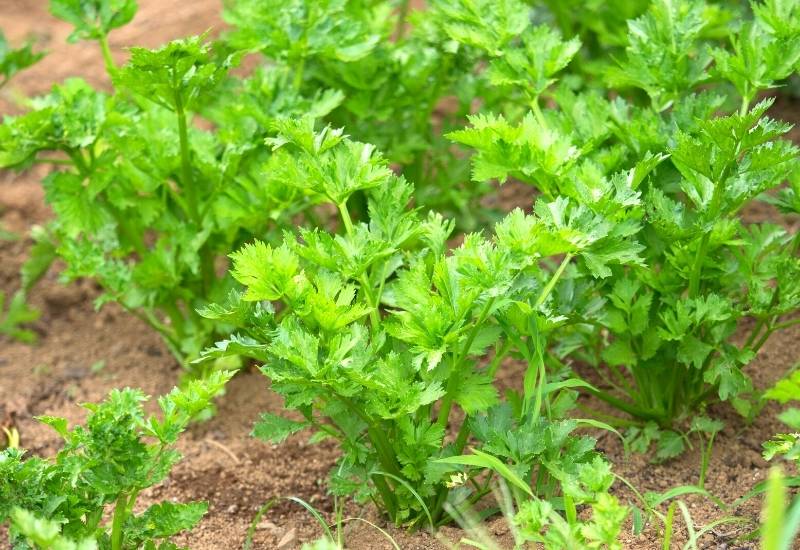
Celery is a hardy biennial that benefits from being grown in the shade of tomatoes, as much like carrots it prefers to be kept cool and protected from intense heat.
Growing celery together with your tomatoes makes efficient use of your space and allows you to take advantage of succession planting while extending the celery season.
How and when to plant with tomatoes:
Celery should be started indoors with tomatoes in the early spring and transplanted outside when the soil temperatures are at least 50℉. Select self-branching varieties rather than trenching celery.
7: Chives

Chives are a commonly grown perennial herb that are hardy and light feeders, making them a good companion for heavy feeding tomatoes.
Chives also produce early blooms of spiky purple flowers that will attract bees in the spring to pollinate the first round of tomato flowers.
Even better, the strong smell of chives, like other alliums, wards off common pests to the tomato plant like aphids.
How and when to plant with tomatoes:
Sow chive seeds in the early spring in a border around the bed where you plan to plant tomatoes. You can also intersperse them through the bed but mark out where you plan to plant the tomatoes so you don’t end up having to dig up the chives you planted.
8: Cilantro
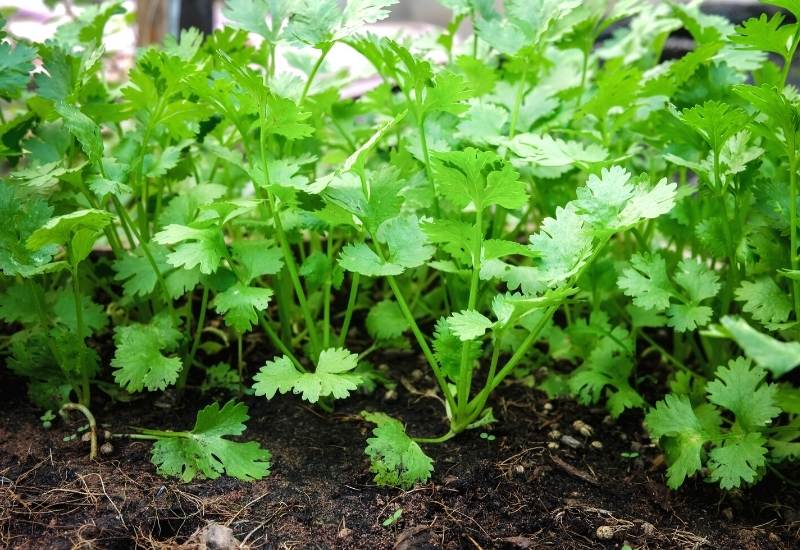
Cilantro is an annual herb that is a good companion for tomatoes because it attracts beneficial insects that can help keep your tomatoes pest-free.
Beneficial insects, like hover flies, will keep harmful insect populations, like aphids, under control with their hungry larvae that feed on them.
Short-lived cilantro plants also just share the space well with tomatoes which take the full season to mature, and you can plant them successionally throughout the year to make use of the space between your tomato plants.
How and when to plant with tomatoes:
Cilantro seeds can be sown between transplanted tomatoes in the spring and then every three weeks as long as the weather permits. In high heat cilantro will bolt quickly, but if you leave them to do so they will self seed in the same area and save you replanting time.
9: Clover

Clover is an excellent companion for tomatoes that will outcompete any weeds and its low growth provides a living mulch on the soil surface to improve moisture retention and shade the soil.
Tomatoes are heavy nitrogen feeders and as a legume, clover fixes nitrogen and can constantly replenish soil nutrients.
How and when to plant with tomatoes:
Sow clover seeds in the spring or fall, just mark out where you plan to transplant your tomatoes. Clover can grow close to the base of the tomato plants, just make sure to continuously cut it back to return nutrients to the soil and prevent any blooms.
10: Cucumber
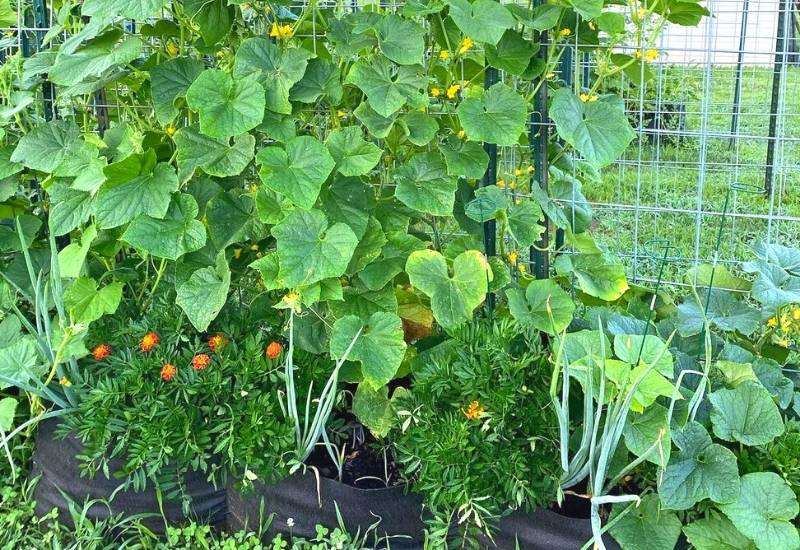
Cucumbers grow well when alternated with tomato plants, as they can use the same trellising structure for support.
Cucumbers are also often left to sprawl on the ground around trellised tomatoes to act as a living mulch, but just growing them side by side (and using a third crop as a living mulch) is still highly beneficial.
Cucumbers and tomatoes share the same needs when it comes to soil moisture and temperature which makes them well suited to live together.
How and when to plant with tomatoes:
Plant cucumber transplants at the same time as you do your tomatoes in the spring when all risk of frost has passed.
Alternate seedlings and plant them at least 18 inches apart from one another to make sure they don’t compete for nutrients.
11: Dill
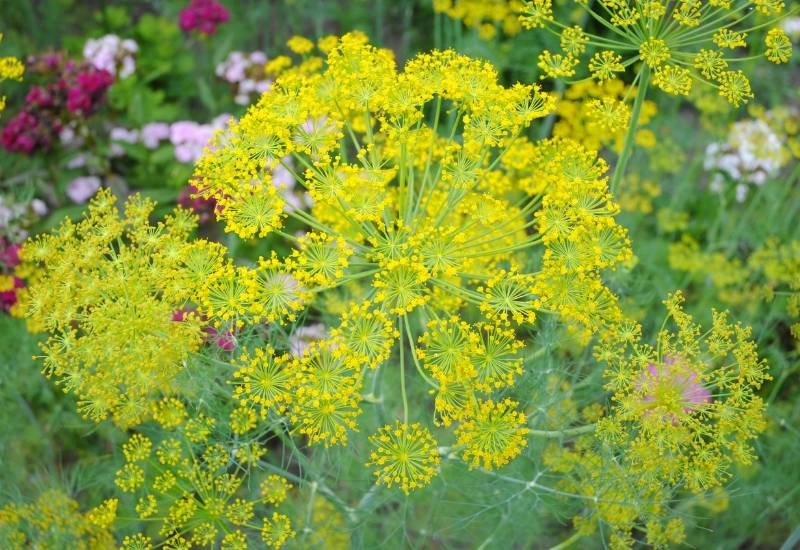
Dill is a perennial herb that will keep pests away from your tomato plants with its powerful scent and also attract beneficial, predatory insects that keep pesky caterpillar and hornworm populations at a minimum.
However, once dill has fully matured it should be moved away from tomato plants as it will begin to have the opposite effect and hinder its growth.
How and when to plant with tomatoes:
Since dill should only be kept with tomatoes while it is young and its mature growth can inhibit it, it is a good idea to keep one of them potted.
Place pots of dill at the end of tomato rows in the spring and early summer, or place your potted tomatoes near in-ground dill.
12: Garlic

Garlic is probably the most famous companion plant in this list, and is used as a pest and fungal deterrent for many diverse crops.
For tomatoes, planting garlic nearby will ward off spider mites with its powerful scent in the same way that a homemade garlic spray would.
Garlic also releases a sulphuric compound in the soil that is a natural anti-fungal and keeps fungal disease pathogens away.
How and when to plant with tomatoes:
Garlic cloves can be planted in the fall or spring at the end of tomato beds or alternated between plants.
Garlic will benefit from mulching just like tomatoes, so you can grow both with a third low-growing crop from this list like certain lettuces.
13: Gooseberry
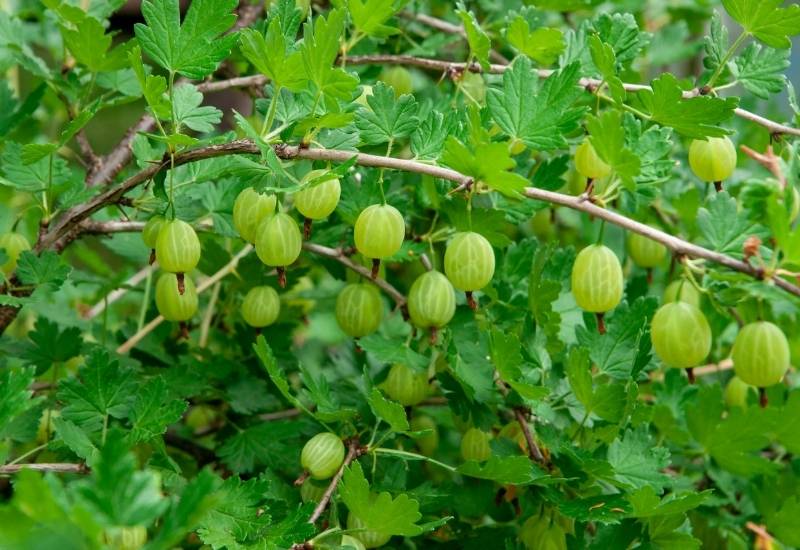
Gooseberry bushes and tomatoes are thought to repel the insect pests of each other, and by planting perennial bushes with annuals you can create a mini agroforestry system.
The flowering gooseberry will attract pollinators and having it established at the end of tomato beds maintains the soil structure season to season.
How and when to plant with tomatoes:
Plant tomato seedlings near gooseberry bushes in the spring, but not so close that you risk damaging the gooseberry roots. You can use the perennial berry bush to delineate the edges of the bed and even use pruned foliage as a mulch for the tomatoes.
14: Lettuce

Lettuce can be interplanted between tomato plants to make efficient use of your space and provide a living mulch for your tomato plants.
Since lettuce is a cool-season crop, it will appreciate the shade provided by the tomato plants while cooling down the soil and retaining moisture.
How and when to plant with tomatoes:
Depending on the variety of lettuce you are growing it might be better to sow seeds or transplant lettuce seedlings in the spring, but either way you should plant them together with your tomatoes once the soil is thawed. You can sow seeds around the base of tomato plants fairly densely and then thin as needed.
15: Marjoram
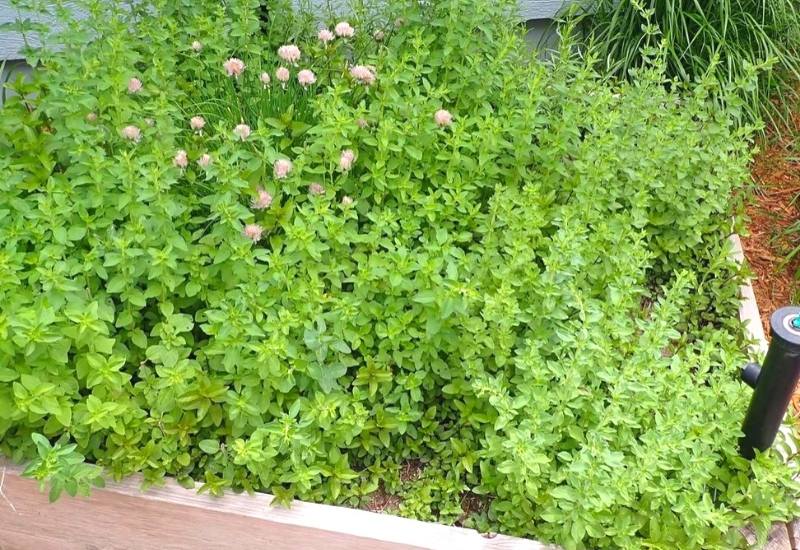
Marjoram, which is closely related to oregano, is a heat-loving perennial herb that pairs well with tomatoes in the garden and in the kitchen.
The flowers will attract pollinators while its scent deters flying pests, and they will both appreciate the same types of soil conditions.
How and when to plant with tomatoes:
As a perennial, marjoram can be planted at the edge of tomato beds where it can establish itself and become a companion for many crop rotations in the future.
Take care to leave at least a few feet of space between the two plants so they each have space to grow.
16: Mint

Mint will repel the aphids that may be attracted to your tomatoes, attract bees with its blooms, and when kept pruned down to a reasonable height will provide a lush mulch for the soil surface.
It will also help retain moisture in the soil and supply the roots of your tomato plant with a controlled and consistent amount of water throughout the season.
How and when to plant with tomatoes:
Sow mint seeds around tomato plants after transplanting. Mint is a vigorous self-seeder that can easily take over a bed, so make sure to keep it under a firm hand in order for it to remain a beneficial companion to your tomatoes.
17: Nasturtiums
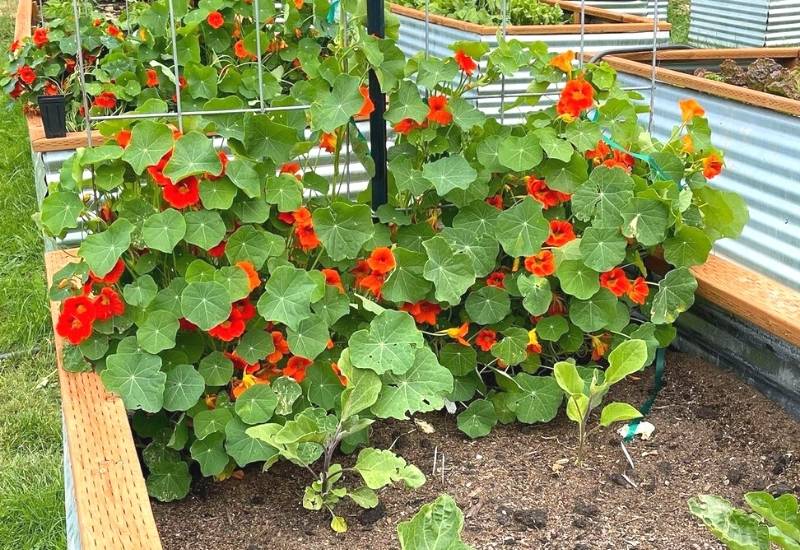
Nasturtiums produce colorful flowers that hit all the marks when it comes to productive blooms: they will attract pollinators, act as a trap for aphids, draw in insects that are aphid predators to feast on them, and lastly the flowers themselves are edible and tasty and will provide you with a bonus harvest!
How and when to plant with tomatoes:
Plant nasturtiums everywhere. At the ends of your beds, interspersed amongst your tomatoes, or hanging in baskets near potted tomato plants they will provide lots of beneficial services to your tomatoes. Pluck flowers to encourage fresh blooms.
18: Onions
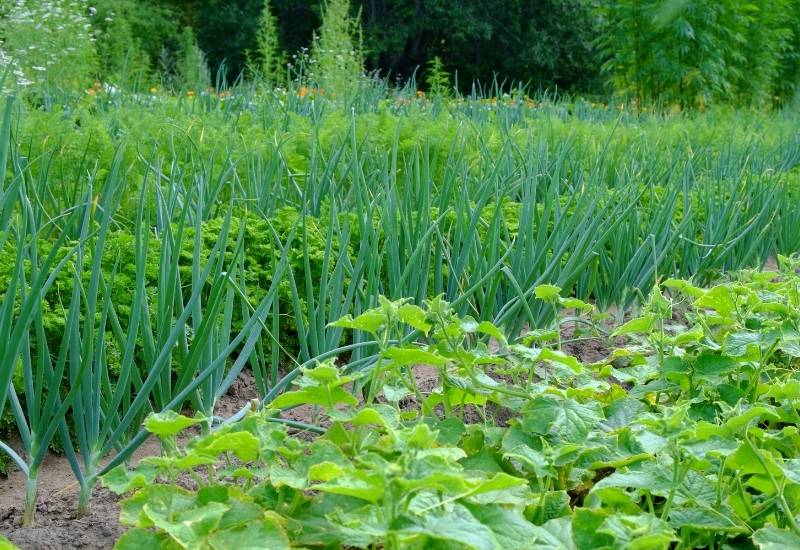
Onions are great companions for your tomatoes for the same reasons that other alliums, like chives and garlic, are.
They deter pests with their characteristic scent, and have a similar growing season to tomatoes that will allow you to clear their shared bed all at once for fall planting.
How and when to plant with tomatoes:
Onions can be sown in the fall or spring, but when planting them with tomatoes it is better to sow them in the spring to avoid damaging bulbs during the tomato transplant.
Make sure not to plant onions with tomatoes if you are already companion planting tomatoes with beans, as beans and onions are foes in the garden.
19: Parsley

Parsley can be intercropped with tomato plants and will enjoy the shade that the taller plants offer. In turn, parsley helps out tomatoes by acting as a living mulch, which controls weeds and retains moisture in the topsoil.
How and when to plant with tomatoes:
Plant parsley seeds or transplants in the spring at the same time or right before you plant your tomato seedlings.
Parsley is a cool-season crop that can be sown again in the fall around remaining tomatoes.
20: Parsnip
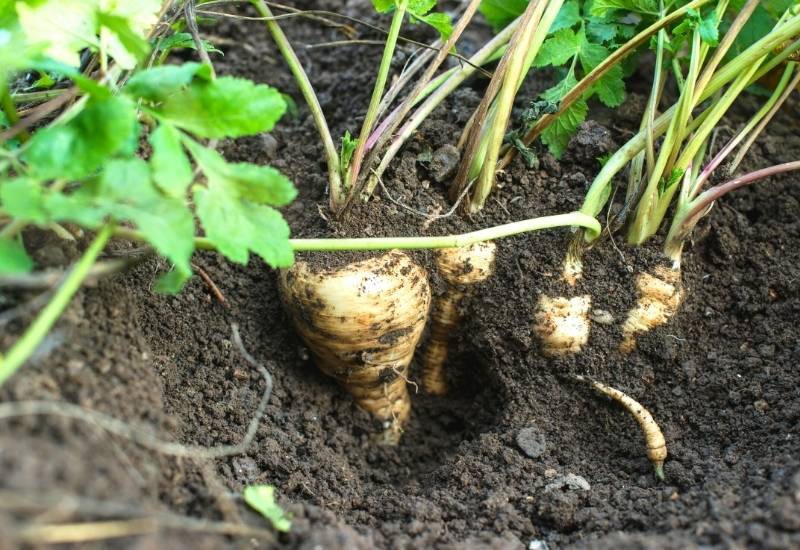
Parsnip is a member of the carrot family and grows well with tomatoes for many of the same reasons that carrot does.
It’s long edible root loosens the soil and brings more oxygen and moisture to the roots of your tomato plant. It is also a cool season crop that will grow well under the shade of bushy tomato foliage.
How and when to plant with tomatoes:
Parsnip seeds can be sown along the edge of beds or interspersed amongst tomato starts in the spring once the ground is workable.
Make sure to choose between either carrots or parsnips for companion planting with your tomatoes, as growing both can attract mutual pests.
21: Peppers
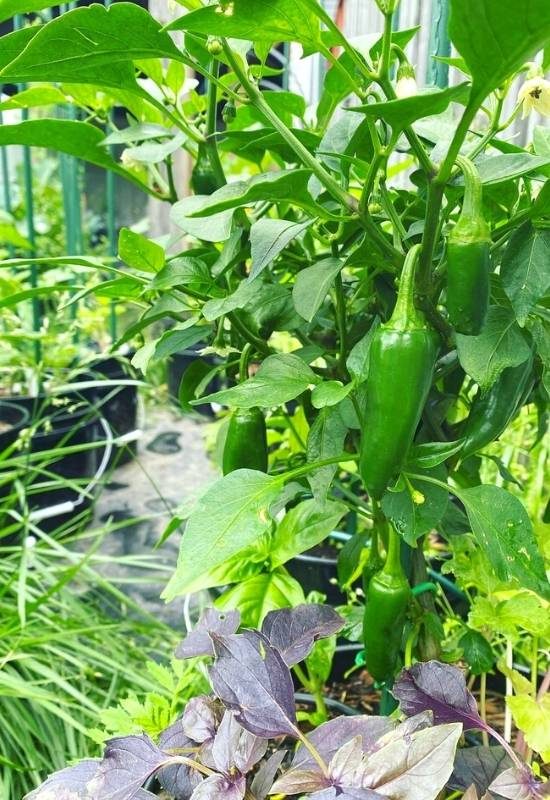
Peppers are also in the Nightshade family and have the same sunlight and soil requirements as tomatoes, and a similar growing season, which makes them well suited to share a bed which can be flipped all at once for fall planting.
Although they can be grown together at the same time, they should not be grown one after another in the same bed as this can lead to the spread of disease pathogens in the soil.
How and when to plant with tomatoes:
Transplant pepper and tomato seedlings into the garden at the same time in the spring. Make sure to space them at least 18-24 inches apart to avoid competition.
22: Sage

Sage keeps away many common pests like the tomato hornworm, flea beetle, and spider mites from your plants.
It is a woody perennial that makes an excellent border for tomato beds, amongst many other crops, and its flowers will also attract pollinators.
How and when to plant with tomatoes:
Since sage is a perennial it will become established where it is planted for several years.
Since tomatoes should be rotated, you can either plant sage all around your garden or keep it in pots that can be moved to wherever you plant your tomatoes season to season.
23: Squash

Squash leaves are broad and flat, and if the vines are left untrellised they provide a good ground cover that shades the soil and controls weeds around tomato plants.
They also appreciate similar growing conditions and soil, and can be planted with a third companion such as beans or borage for optimal growth.
How and when to plant with tomatoes:
Squash seeds can be directly sown into the soil around tomato transplants or started indoors and planted out at the same time.
Make sure there is plenty of space between plants as squash is a notoriously ambitious spreader that can quickly dominate a space.
24: Thyme

Thyme is a fragrant perennial herb that wards off white flies and tomato hornworms with its powerful aroma.
It is low-growing and creates good ground cover, but doesn’t like excessive moisture so should not be used as a living mulch. It is also thought that thyme improves the flavor of tomato fruits when planted together.
How and when to plant with tomatoes:
Thyme is a good candidate for planting at the end of tomato beds, where it will establish itself and pair well with a number of future crop rotations.
5 Antagonistic Plants to Keep Away from Tomatoes
Tomatoes have foes as well as friends in the garden, although luckily there are fewer of them.
Certain plants will affect the growth of your tomato crop due to chemical secretions, competition for nutrients, or because they are both vulnerable to the same pests and diseases.
Avoid planting your tomatoes with these 5 plants:
1: Brassicas (cabbage, broccoli, cauliflower, kale etc.)
Brassicas are infamously bad growing companions for tomatoes, and will stunt the growth of your plants by competing for nutrients.
Since both brassicas and tomatoes are heavy feeders, when planted in the same bed they are constantly stressed and fighting for resources.
Additionally, brassicas are susceptible to some of the same fungal diseases and can create an infection hotspot when planted together.
2: Walnut trees
Tomatoes will not appreciate being planted under the shade of trees with dense foliage, but walnut trees specifically produce an organic compound called juglone that will stunt the growth of tomatoes.
3: Fennel
Although other members of the carrot family make good companions for tomatoes, fennel does not. Certain biochemical secretions from the root system of fennel will actively stunt the growth of nearby plants like tomatoes.
4: Corn
The corn earworm is the same as the tomato fruit worm, and growing the two crops next to each other will create a feast for this pest. Keep them on opposite ends of the garden and planted with companions to keep this particular pest at bay.
5: Potatoes
Growing potatoes and tomatoes together can increase the risk of blight infections in both plants. If you have ever had to deal with blight, you’ll know how devastating it can be so keep them on opposite ends of the garden.
Diversity Creates Resilience!
An intercropped, companion planted garden will be teeming with diversity, beneficial insects, pollinators, and life!
Once you have started planting crops together according to the benefits they provide each other, you will see how much healthier your garden becomes by default.
Pest and disease issues can always arise, but they will be much less likely to succeed in being destructive in a companion planted garden.
Just like in ecosystems, diversity fosters resilience and will create a healthy garden that can bounce back when faced with threats.

Written By
Maya
Maya is a freelance content writer and avid gardener currently based in Sweden. She gained her BA in Environment and Geography in Canada, which is also where she first learnt about the detriments of the industrialized agricultural system. During the summer she began farming through the WWOOF program, and over the next six years has continued to grow and learn at a number of organic farms and gardens across the US and Canada. She is passionate about the role of regenerative agriculture in wildlife conservation and climate change mitigation, and thinks growing your own food is a key part of revolutionizing the system. In her free time she likes to read, garden, and pet nice dogs.

I’ve just hung my tumbling Tomato in the ol’dog rose…. hope the rose rust doesn’t hurt the tomatoes ( cherry type Tom’s)….